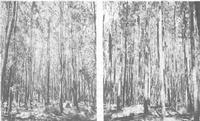


Chapter 4
I Management Of Native Forests
II Plantations-high Productivity Resources
i Exotic pines
ii Native species
III Protecting The Resource
IV Harvesting The Resource
V Solid Wood And Its Processing
VI Minor Forest Products
VII Reconstituted Wood Products
VIII Pulp And Paper
IX Export Woodchips
X Future Directions
XI Acknowledgements
References
Index
Search
Help
Contact us

In the mid-1930s the South Australian Woods and Forests Department started long-term systematic research on thinning, the results of which were first reported by Jolly[15] in 1950. The work was later extended by Lewis et al resulting in the publication of a guide to optimum thinning which has been regarded as a major contribution to pine plantation management in Australia.[16]
Tree breeding
Some species testing was done from the earliest stages of plantation development but tree breeding studies to improve plantation stock in Australia were probably first undertaken in the mid-1930s by the Queensland Forest Service. Controlled pollination was introduced there in the 1940s but from 1954 grafting became the main propagation method.[17] The grafted stock was used to establish seed orchards in 1954 -the first in Australia -and by 1965 these were supplying all Queensland slash pine seed requirements. Plantation productivity gains from this program have exceeded 30 per cent.[18] Studies of Caribbean pine varieties, which were more suitable than slash pine in warmer areas, began in the late 1950s and led to the introduction of the Honduran Caribbean pine, which is now the major species planted in Queensland. Breeding work on this has also been of assistance to many other countries.

In 1937 Jacobs showed that there was sufficient genetic variability in radiata pine to justify breeding programs.[19] Little development was possible until after the Second World War, when radiata pine improvement was advanced by the work of Fielding[20] and others which led in 1957 to the establishment of the first seed orchard for this species. By the early 1970s seed orchards capable of producing genetically improved trees were operating in all States. Eldridge[21] has estimated the overall wood volume gain from this program at 20 per cent over the first generation (about 20 years) with marked improvement in stem and branch quality.
Most of the Úlite trees which were the basis of these programs were selected from existing plantations. Because of threats to the small native stands of radiata pine in its native California and off-shore islands, a major project by CSIRO and the New Zealand Forest Research Institute in 1978 collected seed from a wide variety of sites there and these collections have now been established in provenance trials in Australia, New Zealand and many other countries.
Early provenance testing of maritime pine in Western Australia showed the superiority of a strain from Leira, Portugal and this has since been the basis for seed or-chards. Additional genetic material collected there in 1963-65 has been used in breeding experiments and has produced further substantial gains in volume growth.
The current outlook
Over the past 100 years or so pine plantations have become established as a major new resource, providing in 1985 about one-third of Australia's timber crop from 2 per cent of the total forest area. By the year 2000 well over half our timber will be from this source and the proportion will continue to increase. Productivity is in the range 10-30 m3/ha/yr, several times that of most native eucalypt forests.
Organisations in Australian Science at Work - CSIRO Division of Forest Research; Queensland Forest Service; South Australia. Woods and Forests Dept
People in Bright Sparcs - Dargavel, J. B.; Eldridge, K. G.; Fielding, J. M.; Henderson, V. T; Jacobs, M. R.; Jolly, N. W.; Keeves, A.; Leech, J. W.; Lewis, N. B.; Nelson, P. F.
 |
Australian Academy of Technological Sciences and Engineering |  |
© 1988 Print Edition pages 204 - 205, Online Edition 2000
Published by Australian Science and Technology Heritage Centre, using the Web Academic Resource Publisher
http://www.austehc.unimelb.edu.au/tia/212.html